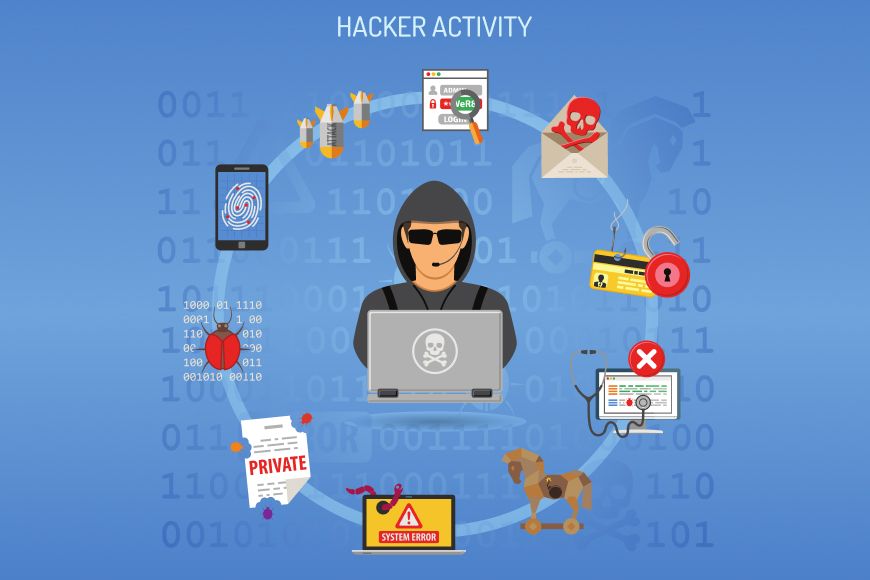The ever-evolving digital landscape has opened up new avenues for both innovation and risks. Today, our dependence on the Internet has made cybersecurity more crucial than ever. And it’s not just about the usual malware like viruses or worms anymore. Advanced online threats are constantly evolving, exploiting new vulnerabilities and slipping through even the most robust defenses.
Today, we will explore the top five advanced online threats that individuals, organizations, and governments should be concerned about, highlighting the nature of these threats, their potential impacts, and how to mitigate them.
1. Ransomware Attacks
Ransomware attacks have become one of the most notorious forms of cyber threats in recent years. This type of malicious software works by encrypting files on the victim’s computer, rendering them inaccessible. The attackers then demand payment, often in a cryptocurrency like Bitcoin, to provide the decryption key.
What makes ransomware particularly concerning is the ability of the attackers to target not just individuals but large organizations, including corporations, healthcare facilities, and government agencies. These entities typically store sensitive data and rely heavily on their digital systems, making them lucrative targets for cybercriminals.
The methods used to initiate a ransomware attack can be diverse, ranging from phishing emails to exploiting software vulnerabilities. Social engineering tactics, where attackers impersonate legitimate entities to deceive the victims, are often used to lure individuals into activating the ransomware.
Beyond the immediate financial demands, ransomware attacks can have severe implications. Systems may be locked down, leading to disruptions in services and operations. In healthcare, for example, delays in accessing patient records can have life-threatening consequences. The reputation damage to an organization can also have long-term effects on client trust and profitability.
Mitigating these risks requires a concerted effort to maintain up-to-date security measures, educate employees and users about potential threats, and develop a robust incident response plan. Vigilance and preparedness can go a long way in protecting against the ever-present danger of ransomware attacks
2. Advanced Phishing Schemes
Phishing schemes are deceptive practices where attackers pose as trustworthy entities to lure individuals into revealing personal or sensitive information. With the increase in technology and data availability, phishing schemes have evolved into more sophisticated and targeted attempts to steal valuable information.
The modern advanced phishing scheme is no longer limited to random, generic emails seeking credit card details. Today, attackers often conduct extensive research on their victims, using social media, public records, and other online tools. This allows them to craft highly personalized and convincing emails, messages, or web pages that mimic legitimate organizations such as banks, government entities, or even colleagues.
The consequence of falling victim to an advanced phishing scheme can be devastating. Individuals might find their bank accounts emptied, credit scores ruined, or personal information sold on the dark web. Organizations, on the other hand, might suffer from substantial financial losses, data breaches, legal liabilities, and irreparable damage to their reputation.
What makes advanced phishing schemes particularly insidious is their ability to adapt and evolve continually. Techniques such as spear phishing, where specific individuals within an organization are targeted, or whaling, where high-level executives are the focus, show the level of refinement that phishing has reached.
Mitigation involves a combination of technological safeguards and human vigilance. Implementing email filtering, using secure communication channels, and educating employees and users about recognizing and reporting suspicious activities are vital steps. Additionally, regular updates to security protocols and systems can provide a robust defense against these increasingly sophisticated and menacing online threats.
3. AI-Powered Cyber Attacks
Artificial Intelligence (AI) is a transformative technology that has revolutionized many industries. However, as much as AI has been a force for good, it has also become a powerful tool in the hands of cybercriminals. AI-powered cyber attacks represent a new frontier in cybersecurity threats, with potential implications that are both vast and alarming.
Unlike traditional cyber attacks, AI-powered attacks utilize machine learning and advanced algorithms to analyze, learn, and adapt to defensive measures. This enables attackers to automate tasks such as identifying vulnerabilities, crafting personalized phishing emails, or even manipulating systems to disguise malicious activities.
These self-learning algorithms can evolve with every attack, learning from their successes and failures, and modifying their strategies accordingly. Such adaptability makes AI-powered attacks not only more efficient but also more difficult to detect and defend against.
One of the most concerning aspects of AI-powered cyber attacks is their potential to operate autonomously. Once initiated, these attacks can continue to probe, attack, and exploit weaknesses without human intervention, making them relentless and highly unpredictable.
The consequences of an AI-powered attack can be catastrophic. From massive data breaches to disruptions in critical infrastructure, the impact is not confined to financial losses but can also affect personal privacy, public safety, and national security.
Mitigation against AI-powered cyber attacks is complex and requires a sophisticated approach. Utilizing AI in defense strategies, employing specialized threat-hunting teams, and leveraging cutting-edge security technologies are essential. Regular updates, continuous monitoring, and collaboration within the cybersecurity community are also vital to staying ahead of these ever-evolving threats.
In a world where AI continues to advance rapidly, understanding and preparing for AI-powered cyber attacks is not just a necessity but a critical responsibility for individuals, organizations, and governments. This new form of threat challenges traditional security paradigms and demands innovative solutions to ensure a secure and resilient digital landscape.
4. Internet of Things (IoT) Vulnerabilities
The Internet of Things (IoT) has become an integral part of our daily lives, connecting everything from home appliances to industrial machinery. This interconnected ecosystem offers incredible convenience and efficiency but also opens up new avenues for cyber threats. The vulnerabilities within IoT devices are emerging as significant concerns in the world of cybersecurity.
Unlike traditional computing devices, many IoT gadgets are designed with functionality and cost-effectiveness in mind, often at the expense of security. They may lack fundamental security features like strong authentication methods or regular security updates, making them susceptible to attacks.
The nature of these vulnerabilities varies widely, from weak passwords and outdated firmware to insecure data storage and communication. Even a seemingly harmless device like a smart thermostat can become an entry point for attackers into a broader network.
When compromised, IoT devices can be used to launch attacks on other connected systems, spy on users, or cause physical damage if they control critical functions, such as heating in a home or machinery in an industrial setting. The implications can be as personal as unauthorized access to private information or as vast as an attack on a city’s infrastructure.
Moreover, the sheer number and diversity of IoT devices create a complex environment that’s challenging to secure. An attack on one vulnerable device can have a domino effect, compromising an entire network.
Mitigating IoT vulnerabilities requires a multifaceted approach. Manufacturers must prioritize security in design, implementing strong authentication protocols, encryption, and regular security patches. End-users must be aware of potential risks and follow best practices such as changing default passwords, updating firmware, and segregating IoT devices on separate networks when possible.
Government regulations and industry standards also play a crucial role in ensuring that IoT devices meet certain security benchmarks. Collaboration between different stakeholders, including manufacturers, regulators, cybersecurity experts, and consumers, is vital in creating a robust defense against the unique and ever-present threats that IoT vulnerabilities pose.
The promise of IoT in enhancing our lives is immense, but it must be balanced with a keen understanding of the risks involved. A proactive, informed approach to security is essential to fully realize the potential of this transformative technology without falling prey to the vulnerabilities it can introduce.
5. Supply Chain Attacks
Supply chain attacks have emerged as a sophisticated and highly effective form of cyber threat. Unlike direct attacks on an individual or organization, these attacks target vulnerabilities within the supply chain, such as suppliers, service providers, or third-party collaborators. The objective is to exploit these weaker links to gain access to the primary target’s systems and information.
The nature of supply chain attacks makes them particularly challenging to detect and prevent. Attackers may infiltrate a lesser-secured component of the supply chain, such as a small vendor or a commonly used software, and then work their way up to the main organization. This indirect approach can bypass traditional security measures, allowing attackers to embed themselves deep within systems before launching their attack.
One alarming aspect of supply chain attacks is the potential scale of the impact. Since many organizations might use the same compromised component, an attacker can simultaneously affect multiple entities. This multiplier effect can lead to widespread disruption and significant financial and reputational damage.
Supply chain attacks also raise concerns over trust and collaboration between organizations and their partners. The need to share information and access across different stages of the supply chain creates opportunities for exploitation. An attack on one part of the chain can lead to mistrust and legal complications, affecting long-term business relationships.
Mitigation against supply chain attacks is a complex task that requires a holistic approach. Organizations must conduct thorough risk assessments of their entire supply chain, understanding the potential vulnerabilities at each stage. Continuous monitoring, stringent security requirements for vendors, and clear contract stipulations for security compliance are crucial.
Collaboration and transparency within the supply chain are equally important. Regular communication, shared security standards, and joint response planning can create a united front against potential attacks. Ensuring that all partners, regardless of size or role, adhere to robust security practices helps in building a resilient defense.
Supply chain attacks signify a shift in cyber warfare, where attackers exploit the interconnected nature of modern business. Recognizing the risks and implementing comprehensive, collaborative security measures across the entire supply chain is not just a best practice but a necessity in today’s intricate and interdependent digital landscape. The fight against supply chain attacks demands a coordinated effort, where trust and vigilance go hand in hand, ensuring a secure and thriving ecosystem.
Conclusion
The landscape of advanced online threats is complex and ever-changing. The top five threats outlined above demonstrate the broad spectrum of risks that individuals and organizations face in today’s interconnected world. While technological advancements have provided new tools for attackers, they have also opened up innovative defense strategies. Embracing a proactive, multi-layered approach to cybersecurity and staying abreast of the latest threats can greatly reduce the risks and enable a safer online environment.
Remember, the battle against cyber threats is not just a matter of technology but also of awareness, education, and constant vigilance. By understanding the threats and implementing robust security measures, we can build a stronger defense against the unseen enemies of the digital world.



